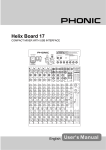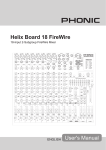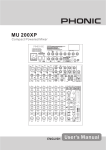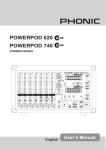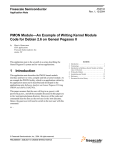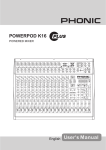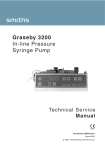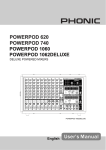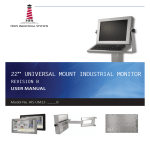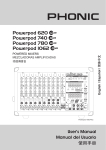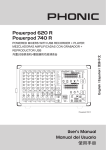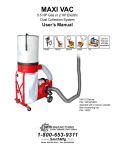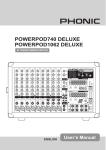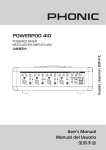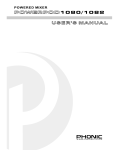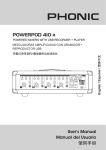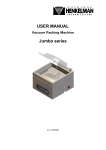Download Phonic Powerpod Molded Powered Mixer
Transcript
IMPORTANT SAFETY INSTRUCTIONS 1. Read these instructions before operating this apparatus. ������� 2. Keep these instructions for future reference. ���� �� �������� ����� �� ��� ���� 3. Heed all warnings to ensure safe operation. 4. Follow all instructions provided in this document. 5. Do not use this apparatus near water or in locations where condensation may occur. CAUTION: TO REDUCE THE RISK OF ELECTRIC SHOCK, DO NOT REMOVE COVER (OR BACK) NO USER SERVICEABLE PARTS INSIDE REFER SERVICING TO QUALIFIED PERSONNEL 6. Clean only with dry cloth. Do not use aerosol or liquid cleaners. Unplug this apparatus before cleaning. The lightning flash with arrowhead symbol, within an equilateral triangle, is intended to alert the user to the presence 7. Do not block any of the ventilation openings. Install in accordance with the manufacturer’s instructions. of uninsulated “dangerous voltage” within the product’s enclosure that may be of sufficient 8. Do not install near any heat sources such as radiators, heat registers, stoves, or other apparatus (including amplifiers) that produce heat. 9. Do not defeat the safety purpose of the polarized or grounding-type plug. A polarized plug has two blades with one wider than the other. A grounding type plug has two blades and a third grounding prong. The wide blade or the third prong is provided for your safety. If the provided plug does not fit into your outlet, consult an electrician for replacement of the obsolete outlet. 10. Protect the power cord from being walked on or pinched particularly at plug, convenience receptacles, and the point where they exit from the apparatus. 11. Only use attachments/accessories specified by the manufacturer. 12. Use only with a cart, stand, tripod, bracket, or table specified by the manufacturer, or sold with the apparatus. When a cart is used, use caution when moving the cart/apparatus combination to avoid injury from tipover. 13. Unplug this apparatus during lighting storms or when unused for long periods of time. 14. Refer all servicing to qualified service personnel. Servicing is required when the apparatus has been damaged in any way, such as power-supply cord or plug is damaged, liquid has been spilled or objects have fallen into the apparatus, the apparatus has been exposed to rain or moisture, does not operate normally, or has been dropped. ! magnitude to constitute a risk of electric shock to persons. ! The exclamation point within an equilateral triangle is intended to alert the user to the presence of important operating and maintenance (servicing) instructions in the literature accompanying the appliance. WARNING: To reduce the risk of fire or electric shock, do not expose this apparatus to rain or moisture. CAUTION: Use of controls or adjustments or performance of procedures other than those specified may result in hazardous radiation exposure. POWERPOD 745 / 865 / 885 PLUS Molded Powered Mixer page FEATURES .............................................................................................................. 4 INTRODUCTION ...................................................................................................... 4 BASIC SETUP ......................................................................................................... 5 Getting Started ..................................................................................................... 5 Channel Setup ..................................................................................................... 5 INSTALLING RACK MOUNT KIT ............................................................................ 6 EXPANSION SLOT FOR WIRELESS MICROPHONE ............................................ 6 UTILIZING THE MOLDED MIXER........................................................................... 7 MAKING CONNECTIONS ....................................................................................... 8 Channel Inputs ..................................................................................................... 8 Master Section ..................................................................................................... 8 Rear Panel ........................................................................................................... 9 CONTROLS AND SETTINGS................................................................................ 10 Rear Panel ......................................................................................................... 10 Channel Controls ............................................................................................... 10 Digital Effect Section .......................................................................................... 11 Master Section ................................................................................................... 11 APPLICATION ...................................................................................................... 13 DIGITAL EFFECT TABLES.................................................................................... 14 DIMENSIONS......................................................................................................... 15 SPECIFICATIONS.................................................................................................. 16 BLOCK DIAGRAMS .............................................................................................. 18 Phonic reserves the right to improve or alter any information suppied within this document without prior notice. V1.0 NOV. 12, 2004 INTRODUCTION Thank you for choosing one of Phonic’s many quality powered mixers. The unique Powerpod Molded Powered Mixers – innovated by the same talented engineers that have created a variety of mixers fantastic in style and performance in the past – display similar proficiency that previous Phonic products have shown; with more than a few refinements, of course. The all new Powerpod Molded Powered Mixers feature full gain ranges, amazingly low distortion levels, and incredibly wide dynamic ranges, just showing the dominance these small machines will have in the mixing World. The innovative features of Powerpods 745, 865 and 885 Plus are obvious at first glance. The new molded casing provides not only added durability, but versatility that has previously been unavailable in mixers. Thanks to the Powerpod Molded Mixers’ construction, you can simply place the mixer on a desk-top or other surface to sit at a 45° angle for a better view of controls and easier utilization of the mixer. It is also possible to mount the new Powerpods on a unique tri-pod stand, allowing users to bring the mixer up into their focal visual and dextral range. Because of the over-all distinctiveness of the Powerpods 745, 865 and 885 Plus, we know by now you’re already extremely eager to get started and see what this baby can do, but before you do we strongly urge you to take a look through this manual. Inside, you will find important facts and figures on the set up, use and applications of your brand new mixer. If you do happen to be one of the many people who flatly refuse to read user manuals, then we just urge you to at least glance at the Instant Setup section. After glancing at or reading through the manual (we applaud you if you do read the entire manual), please store it in a place that is easy to find, because, chances are, there is something you missed the first time around. FEATURES Common Features ● Angled molded cabinet ● Dual 7-band graphic equalizers with feedback detection system ● Vocal eliminator for Karaoke ● Solid Phonic System speaker enhancement ● 2 Super Hi-Z inputs optimized for direct input of acoustic electric guitars and electric guitars or basses ● 2 built-in limiters ● 3-band channel EQ, 2 channels with sweepable mid-range ● Monitor and effect sends on each input channel ● +48V phantom power ● Record output with trim control for recording level matching ● Handy mini-stereo I/O for MD, MP3 player/ recorder, input with level control ● 2 speakon and 5 1/4" phone jacks for speaker connection Powerpod 745 Plus ● 220W + 220W / 4 ohms amplifier for main 1 & 2 or main / monitor (Bridge mono, 440W / 8 ohms) ● 24-bit digital stereo multi-effect processor with 16 preset programs and foot switch controllability ● 7 balanced mic inputs through XLR jacks ● 10 line inputs through 1/4" jacks ● Pad control on channel 1~4 ● One aux input Powerpod 865 Plus ● 300W + 300W / 4 ohms amplifier for main L & R or main / monitor (Bridge mono, 600W / 8 ohms) ● 24-bit digital stereo multi-effect processor with 16 programs plus one main parameter control, tap control and foot switch jacks ● 8 balanced mic inputs through XLR jacks ● 10 line inputs through 1/4" jacks ● Pad control on channel 1~6 ● Stereo aux input ● Optional tripod stand to raise cabinet, model number S3 ● Optional rack-mounting kit, model name ERPLUS ● 400W + 400W / 4 ohms amplifier for main L & R or main / monitor (Bridge mono, 800W / 8 ohms) ● Wireless mic tuner compartment for optional module, model number VM11 (VHF Handheld system), VM22 (VHF executive system), UM11 (UHF Handheld system) and UM22 (UHF executive system) ● 24-bit digital stereo multi-effect processor with 16 programs plus one main parameter control, tap control and foot switch jacks ● 8 balanced mic inputs through XLR jacks ● 10 line inputs through 1/4" jacks ● Pad control on channel 1~6 ● Stereo aux input page 4 Powerpod 885 Plus POWERPOD 745 / 865 / 885 User's Manual PHONIC BASIC SETUP Getting Started 1. Ensure all power is turned off on the Molded Mixer. To totally ensure this, the AC cable should not be connected to the unit. 2. All faders and level controls should be set at the lowest level and all channels switched off to ensure no sound is inadvertently sent through the outputs when the device is switched on. All levels should be altered to acceptable degrees after the device is turned on. NB. Ensure that the rear of the mixer is not less than 30 centimeters from the wall, as being closer than that may obstruct the cooling fans and cause overheating. 3. Plug all necessary instruments and equipment into the device's various inputs as required. This may include line signal devices, as well as microphones and/or guitars, keyboards, etc. 4. Plug any necessary equipment into the device's various outputs. This could include speakers, monitors, signal processors, and/or recording devices. NB. No devices other than speakers should be connected to the power amp outputs. Plugging inappropriate devices into the mixer will likely cause damage to the device. Also, guitar cables should not be used to connect amplifiers to speakers. 5. Plug the supplied AC cable into the AC inlet on the back of the device, ensuring the local voltage level is identical to that required on your device. Channel Setup 1. To ensure the correct audio level of the input channel is selected, each of the level input controls of the Mixer should be turned counterclockwise as far as they will go (which is the 0 mark). 2. No input other than the one being set should have any device plugged in. This will ensure the purest signal is used when setting channels. 3. Set the level control of the channel you are setting to the 0 dB mark. 4. Set the master level controls (main & monitor) to around the 12 o’clock position. 5. Ensure the channel has a signal sent to it similar to the signal that will be sent when in common use. For example, if the channel is using a microphone, then you should speak or sing at the same level the performer normally would during a performance; if a guitar is plugged into the channel, then the guitar should also be strummed as it normally would be (and so on). This ensures levels are completely accurate and avoids having to reset them later. 6. Set the channel level control so the Level Meter indicates the audio level is around the 0 dB mark. 7. This channel is now ready to be used; you can stop making the audio signal. 8. You can repeat the same process for other channels. 6. Plug the supplied AC cable into a power outlet of a suitable voltage. 7. Turn the power switch on. PHONIC CORPORATION POWERPOD 745 / 865 / 885 User's Manual page 5 INSTALLING RACK MOUNT KIT An optinoal rack mount kit ER-PLUS can easily be added to your Powerpod Molded Powered Mixer, allowing it to be installed into a standard 19" rack. To do so, the handles of the Molded Mixer should first be removed, as indicated in the pictures below. After removing the Powerpod Molded Powered Mixers' handles, attach the rack mounting kit parallel to either side of the mixer face using the screws provided along with the optional kit. Ensure the kit is firmly attacked before attempting to attach the Powerpod Mixer to a rack. After attaching the Powerpod Molded Powered Mixer to your audio rack, you may then set up all your inputs and outputs as may be necessary. The Powerpod Molded Mixer will take up 7 standard units of rack space. EXPANSION SLOT FOR WIRELESS MICROPHONE You may have noticed a small door on the side of your Powerpod Molded Mixer, which, inside, has a small expansion slot. Do not panic! This is for the addition of a wireless microphone module (either the UM11, VM11, UM22 or VM22, not included with this mixer). By simply inserting your wireless mic module into the expansion slot, and screwing it into place, you can then use wireless microphones along with your Powerpod Molded Mixer. The signal of the wireless microphone is defaultly routed to the channel 1 input. page 6 POWERPOD 745 / 865 / 885 User's Manual PHONIC UTILIZING THE MOLDED MIXER At A 45° Angle or Perpendicular To The Ground Use the special molded casing's unique design allows the Powerpod Molded Powered Mixer to sit at an angle that best suits your needs and your environment. Mounted On A Tripod Optional tripod stand, model name S3. Attach tripod stand's connection plate to Mixer using screws provided. PHONIC CORPORATION By using the optional tripod stand you are able to maintain the best control over your mixer's position. POWERPOD 745 / 865 / 885 User's Manual page 7 MAKING CONNECTIONS Channel Inputs The Powerpod 865 and 885 Molded Powered Mixers provide users with a total of 8 input channels, 2 of which accept stereo signals and another 2 that accept Super Hi-Z signals. The Powerpod 745 Plus, on the other hand, provides a total of 7 input channels, including 3 dual mono input channels and two Super Hi-Z inputs. The stereo and dual mono channels on each device feature both XLR microphone inputs, as well as two 1/4" line inputs, and do not feature PAD buttons. Master Section 5. Effect Out This 1/4" TS outputs may be used to connect to an external digital effect processor, or even to an amplifier and speakers (depending on your needs), to the mixer; the level of which is determined by the Effect controls on each input channel. 6. Foot Switch Jacks 1. XLR Microphone (Low-Z) Inputs These jacks accept XLR Microphone inputs. They can be used in conjunction with such microphones as professional condenser, dynamic or ribbon microphones with standard XLR male connectors. With low noise preamplifiers, these inputs serve for crystal clear sound replication. NB. When using an unbalanced microphone, please ensure phantom power is switched off. However, when using condenser microphones the phantom power of the corresponding channel should be activated. 2. Line (Hi-Z) Inputs These inputs accept typical 1/4" TRS or TS inputs, for balanced or unbalanced signals. By pushing the PAD button, guitars, synthesizers, and other high-level input devices can be safely connected to these inputs. 3. Line (Super Hi-Z) Inputs These unbalanced 1/4" phone jack inputs are best suited for direct input of acoustic electric guitars, electric guitars, bass guitars, and other instruments like synthesizers and drum machines. 4. Stereo / Dual Mono Channel Inputs Each of the Powerpod Molded Powered Mixers provide at least 2 stereo input channels (or dual mono on the Powerpod 745 Plus), the inputs of which differ slightly to the mono channels. The 3-pin XLR inputs are for the addition of microphones with typical XLR male inputs, where the two Line 1/4" TS jacks are for the addition of various stereo line level input devices, such as keyboards. If you wish to use a monaural device on a stereo return input, simply plug the device’s 1/4" phone jack into the left (mono) input and leave the right input bare. The signal will be duplicated to the right due to the miracle of jack normalizing. page 8 These ports are for the inclusion of a momentary-type foot switch, used to remotely adjust properties of the builtin Digital Effect Engine. The Powerpod 745 Plus features a single foot switch jack, allowing users to turn the Digital Effect Engine on and off. The Powerpods 865 and 885 Plus, on the hand, features two foot switch jacks: the uppermost jack is used for turning on and off of digital effects, where the lower jack is used to adjust the tap delay properties. 7. AUX In These 1/4" phone jack inputs are for the return of audio to the Powerpod Molded Mixers, processed by an external signal processor. If really needed, they can also be used as additional inputs, with a level control located on the face of the mixer. The Powerpod 745 Plus features a mono AUX In, whereas both the Powerpod 865 and 885 Plus feature stereo AUX Inputs. The stereo AUX inputs can also accept mono signals, however, by simply plugging the 1/4" phone jack of any device into the Left stereo input, the signal of which will be duplicated to the Right input. 8. Tape In The first of these inputs accommodates RCA cables from such stereo devices as tape and CD players. In addition to these inputs, however, Phonic has incorporated a mini stereo port for the inclusion of mini disc (MD), portable CD, and MP3 players (such as the Apple iPod), as well as laptop computers. The line from this feed is directed to the Tape In mixing bus, before being fed through to the Main L/R mixing bus. POWERPOD 745 / 865 / 885 User's Manual PHONIC One Speaker per Channel: When connecting a single speaker to each channel's output, speakers with impedances between 4 and 8 ohms should be used. This is the case for both the Phone Jack and Professional Speaker Connectors. 9. Record Outputs As with the Tape In ports, these outputs will accommodate RCA cables, able to feed a variety of stereo recording devices. Also included are mini stereo ports for the addition of recording devices such as MD players and laptop computers. Accompanying these outputs is a handy trim control, allowing users to adjust the Record Out level for easier level matching when recording. Two Speakers per Channel: When connecting two speakers to the Speaker Outputs, the loading of each speaker should be between 8 and 16 ohms (as two 8 ohm speakers will form a total loading of 4 ohms, two 16 ohm speakers a total loading of 8 ohms, etc). 10. Main Output The Main output port will output the final stereo line level signal sent from the main mixing bus, allowing users to feed external devices that may run in parallel with the mixer. This may include additional power amplifiers, mixers, PA systems, as well as a wide range of other possible signal processors. The Powerpod 745 Plus features a single Main out jack, whereas the Powerpods 865 and 885 Plus feature stereo Main outputs. Three Speakers per Channel: If you wish to connect to all three speaker outputs, the loading of each speaker should be between 12 and 16 ohms (since three 12 ohm speakers will create a total loading of 4 ohms). 11. Monitor Output The Monitor output port can be used to send the audio signal to external devices, such as powered monitors, for artists or engineers to monitor audio. The signal for this output is taken from the monitor mixing bus, the final level of which is controlled by the Master Monitor level control, which takes its signal from the Monitor controls on each individual input channel. Rear Panel 12. Speaker Outputs These jacks are used to connect to speakers, fed from the internal power amplifiers A and B. The first set of outputs (A-1 and B-1) are professional speaker (Speakon) connectors; to use these, insert an appropriate four pin plug into the connector, and twist to lock into place. The second set of outputs (A-2, A-3, B-2 and B-3) are 1/4" phone jacks; to use these, simply insert an appropriate 1/4" TS plug into them. Accompanying these outputs is a Mono Bridge output, which solely outputs the main mono signal with the combined power of both built-in amplifiers. PHONIC CORPORATION Bridge Mono: When using bridge mono mode, either the Bridge Mono (1/4" phone jack) output connection or Professional Speaker output A-1 connection can be used (however should not be used simultaneously). The total loading of the speaker used should be no less than 8 ohms. NB. Only use passive speakers in conjunction with the Speaker outputs, as to avoid damaging any equipment. When connecting to professional speaker connector A1, power amp A can be utilized through pins 1+ and 1-, power amplifier B can be utilized through pins 2+ and 2-. For professional speaker connector B-1, power amplifier B can be utilized through pins 1+ and 1-. Pins 2+ and 2- are not used on professional speaker connector B-1. When in bridge mono mode, pins 1+ and 2+ on speakon jack A-1 are used only. POWERPOD 745 / 865 / 885 User's Manual page 9 13. Mains Power Inlet This port is used to plug the socket end of the included AC cable. The other end should be connected to an appropriate power source. Ensure you check local voltage levels are consistent with those needed by this device before attempting to connect to a power source. CONTROLS AND SETTINGS Rear Panel 14. Power Button This button is used to turn the Powerpods 745, 865 and 885 Plus on or off. It is advisable to ensure all level controls are a minimum before turning the device on. Channel Controls 15. HIGH (High Frequency) Control This control is used to give a shelving boost or cut of ±15 dB to high frequency (12 kHz) sounds. This will adjust the amount of treble included in the audio of the channel, adding strength and crispness to sounds such as guitars, cymbals, and synthesizers. 16. MID (Middle Frequency) Control This control is used to provide a peaking style of boost and cut to the level of middle frequency sounds at a range of ±15 dB. On channels 1 and 2 of the Powerpod Molded Powered Mixers, a frequency control is also provided, allowing you to select a center frequency between 100 Hz and 8 kHz. On all other channels, the middle frequency is set at 2.5 kHz. Changing middle frequencies of an audio feed can be rather difficult when used in a professional audio mix, as it is usually more desirable to cut middle frequency sounds rather than boost them, soothing overly harsh vocal and instrument sounds in the audio. page 10 17. LOW (Low Frequency) Control This control is used to give a shelving boost or cut of ±15 dB to low frequency (80 Hz) sounds. This will adjust the amount of bass included in the audio of the channel, and bring more warmth and punch to drums and bass guitars. 18. Monitor Control This control alters the signal level that is being sent to the Monitor mixing buses, the signal of which is suitable for connecting stage monitors, allowing artists to listen to the music that is being playing. 19. Effect Control This control alters the signal level that is sent to the Effect output, which can be used in conjunction with external signal processors (the signal of which can be returned to mixer via the stereo return inputs), or simply as additional auxiliary outputs for any means required. The Effect control also adjusts the level of audio that is sent to the built-in digital effect engine. 20. PAN/BAL Control (Powerpods 865 and 885 Plus only) This alternates the degree or level of audio that the left and right side of the main mix should receive. On mono channels, this control will adjust the level that the left and right should receive, where as on a stereo channel (provided the channel is receiving a stereo signal), adjusting the BAL control will attenuate the left or right audio signals accordingly. 21. Level Control This control will alter the signal level that is sent from the corresponding channel to the main mixing bus. This level control will also affect the level of audio sent to the effect send. 22. PAD Button The PAD button is used to attenuate the input signal of the corresponding channel by 25 dB. This should be pushed in when using line level input devices, or devices of a higher signal level. POWERPOD 745 / 865 / 885 User's Manual PHONIC 28. Tap Delay Button and Indicator (Powerpods 865 and 885 Plus only) When the tap delay effect is selected, this button is used to determine the delay time. By pushing the button several times, the mixer interprets the time between last two pushes and remembers this as the delay time until the button is pushed again. When the tap delay effect is selected, the corresponding LED will flash at the intervals selected. Master Section 29. Graphic Equalizer and Feedback Detection System Digital Effect Section 23. Digital Effect Display This panel displays the titles of different effects that can be added to audio. When you select the effect, the LED imbedded next to the effect name will illuminate and the alteration be applied automatically. 24. Program Control This control is used to scroll through the various effects shown on the Digital Effect Display. Turning the control will automatically change the effect and apply it to the mix. Each of the Powerpod Molded Mixers features two 7 band graphic equalizers that allow the user to adjust the frequency response of the Main Left and Right signals (Main 1 and 2 on the Powerpod 745 Plus) or Monitor and Main signals, as selected by the GEQ select switch. The graphic equalizers provide a maximum of 12 dB of cut or boost on each frequency. One feature, built into the Powerpod Molded Mixer graphic equalizers, is a Feedback Detection System. The individual LEDs located on the slide VR controls of the equalizer will illuminate when feedback occurs on those particular frequency band. By reducing the level of any frequency band that has an illuminated LED you can quite effectively remove feedback from your audio; after which the LED will turn off. If an LED flashes, yet you are unable to hear any feedback, it is probably best not to adjust the level. When feedback occurs, the LED will generally light up and remain lit. 30. EFX to Mon/Main Controls 25. Parameter Control (Powerpods 865 and 885 Plus only) This will adjust the one main parameter of the digital effect that is currently applied to the audio feed. Please refer to the Digital Effects Table for more information on Effect parameters. 26. Peak Indicator (Powerpods 865 and 885 Plus only) This LED indicator will illuminate when the Digital Effect Processor overloads. It is best to adjust the Effect control on input channels so as to ensure the Peak indicator does not light up. This will ensure a greater quality overall of audio. These controls, one located below each of the Graphic Equalizers, allow users to adjust how much of signal processed by the built-in effects processor is sent to the Main or Monitor mixing buses accordingly. 31. Tape In Controls These controls, located below each of the Graphic Equalizers, are used to adjust the level of the Tape In input that will be sent to the main or monitor mixes, accordingly. 32. AUX In Control This control, located below the Main Graphic Equalizer, is used to adjust the level of the AUX In input, that will be sent to the main mix. 27. DSP Effect On Button and Indicator This button is pushed to turn the corresponding effect panel on or off. When the effect processor is turned on, the corresponding LED illuminates. PHONIC CORPORATION POWERPOD 745 / 865 / 885 User's Manual page 11 33. GEQ Select Switch The GEQ switch, located below the Monitor Graphic Equalizer, allows you – the user – to decide how to utilize the two Graphic Equalizers to best suit your needs. When switched to the uppermost position, the Graphic EQs will be used for the Monitor and Main signals. When set in the lower position, the Graphic EQ will be used to adjust the Main left and right (or Main 1 and Main 2, for the Powerpod 745 Plus) signal properties separately. The feedback detection system is always used for whatever signal the equalizer is utilized to. 34. Vocal Eliminator Pushing this switch in enables you to eliminate vocal sections of any signal fed from a CD or tape player (or any other input device) into the Tape In inputs. Using phase cancellation of vocal frequency ranges between the left and right channels, the Powerpod Molded Mixer’s vocal eliminator can effectively remove vocals panned dead center. This is particularly useful for Karaoke application. 35. Power Indicator The Power Indicator, located above the Monitor Level Meter, will light up when the power of the Powerpod Molded Mixer is switched on. 36. LED Level Meters These 5-segment LED level meters show the output levels of their corresponding signals. The Monitor output features a mono level meter, whereas the Main output has a stereo meter for Main Left and Right (Main mono on the Powerpod 745 Plus) signals on the Main meter. The LEDs give you a constant visual warning of excessive peaks in signals that might cause overloading. Adjusting the output level control to cause indicator lights to occasionally sit at the 0 position will ensure you get little to no distortion. These meters are in no way changed when the GEQ selection switch is used (in case you were wondering). 39. Amp Select Switch and Built-in Limiter This switch allows users to alternate between the different signals that can be processed by the built-in power amp and routed to the speaker outputs on the rear of the device. It enables users to select from: L / R (ie. Stereo, or the Main 1 and 2 outputs of the Powerpod 745 Plus); Main L+R / Mon, and; Bridge Mono – which is output via either professional speaker (Speakon) output A-1 or 1/4" (L+R) Bridge output only – ensuring the Powerpod Plus mixers can be used for most any possible speaker configuration. NB. When using a mono bridge connection, do not connect a speaker to either the 1/4" phone jacks or the professional speaker jack B-1 speaker connector, located on the rear of the mixer. 40. sPs (Solid Phonic System) Speaker Enhancement Switch and Indicator Using this switch will enable the user to give their sound a little lift to improve the overall robustness of the audio. It basically cuts very low frequency sounds, those which are barely audible to the human ear, and gives a slight boost to frequencies just above the cut ones. Cutting the unnecessary low frequency sounds then allows the power amplifier to direct its energy to the more important frequencies of your audio. It may be desirable to audition the mixer’s sound with this switch on and off, and decide which is better for your purposes. Activation of the sPs switch is accompanied by an illuminated LED. 41. Stand-by Switch and Indicator This switch enables and disables a mute of channels 1 through to 8 on the 865 and 885 Plus, and channels 1 through to 7 on the 745 Plus. This feature is handy in live performances, due to the fact that the Tape In and stereo AUX Returns are not muted when activated, allowing an audio signal from CD players or other input devices to be played during performance breaks, while still ensuring microphones fail to produce hideously sounding feedback. Activation of the stand-by switch is accompanied by an illuminated LED that, when on, will flash. 37. Master Controls The two VR Master level controls allow users to adjust the final output of the Monitor and Main left and right signals (Main mono on the Powerpod 745 Plus), before sending the signals to the built-in power amplifier. 38. Phantom Power Switch and Indicator When this switch is in the on position it activates +48V of Phantom Power for channels 1 through to 8 on the 865 and 885 Plus, and channels 1 through 7 on the 745 Plus, allowing condenser microphones to be used on these channels. The corresponding LED will illuminate when the Master Phantom Power is activated. Ensure you turn the channel level control, as well as the main and monitor master level controls, to a minimum (meaning all the way to the left) before activating Phantom Power, as to avoid causing unwanted noise, or even damage to your audio system. page 12 POWERPOD 745 / 865 / 885 User's Manual PHONIC APPLICATION PHONIC CORPORATION POWERPOD 745 / 865 / 885 User's Manual page 13 DIGITAL EFFECT TABLES POWERPOD 745 PLUS Program Name Program Description Type VOCAL 1 VOCAL 2 VOCAL 3 ECHO 1 ECHO 2 DELAY S. HALL Ideal for vocals Ideal for vocals Ideal for vocals Ideal for Echoing vocals Ideal for Echoing vocals Delays the audio signal This reverb simulates a moderately size hall M. HALL L. HALL CATH This reverb simulates a medium sized setting This reverb simulates a large, expanse setting, such as a concert hall Creates acoustics similar to those of a Cathedral. Reverb Reverb Reverb ROOM 1 Creates acoustics similar to those of a small room Reverb ROOM 2 Creates acoustics similar to those of a small room Reverb PLATE 1 Simulates a small plate reverb device, creating hard sounding Reverberation Simulates a medium plate reverb device, creating hard sounding Reverberation Produces effect by cutting the reverberation Adds a sense of pitch to the sound Reverb PLATE 2 GATE REVERB FLANGE Echo + Reverb Echo + Reverb Echo + Reverb Echo Echo Delay Reverb Reverb Reverb Flange + Reverb POWERPOD 865 / 885 PLUS Program Name HALL Program Description Controllable Parameter Parameter Variable Range Reverb Time 0.3 – 10.0 sec GATE REVERB This reverb simulates a large, expanse setting, such as a concert hall Creates acoustics similar to those of a small room Simulates a Plate Reverb device, creating hard sounding Reverberation Ideal for Reverb of vocals Ideal for Reverb of vocals Ideal for Echoing vocals Ideal for Echoing vocals Delays the audio signal Delays the audio signal Modifies early reflections, creating a deeper sound or an echo-like effect Produces effect by cutting the reverberation DOUBLER Creates an effect simulating 2 vocalists Pitch Fine 0 – 50 SYMPHONIC FLANGE Adds richly layered depth to the sound Adds a sense of pitch to the sound 0 – 100% 0.05 – 4.00 Hz DISTORTION TAP DELAY Used to distort the sound Allows you to select the delay time by clicking a button twice or by use of a footswitch. The amount of feedback is adjusted using the PARAMETER control. Depth Modulation Frequency Drive Feedback Gain 0 – 99% Delay Time 100 ms(600bpm) – 2690 ms(22.3bpm) ROOM PLATE REVERB VOCAL 1 REVERB VOCAL 2 ECHO 1 ECHO 2 DELAY 1 DELAY 2 EARLY REF. page 14 POWERPOD 745 / 865 / 885 User's Manual Reverb Time Reverb Time 0.3 – 3.2 sec 0.3 – 10.0 sec Reverb Time Reverb Time Delay Time Delay Time Delay Time Delay Time Room Size 0.3 – 10.0 sec 0.3 – 10.0 sec 0 – 800 ms 0 – 800 ms 0 – 800 ms 0 – 800 ms 0.1 – 10.0 Room Size 0.1 – 5.0 0 – 100% PHONIC DIMENSIONS Measurements are shown in mm/inch PHONIC CORPORATION POWERPOD 745 / 865 / 885 User's Manual page 15 SPECIFICATIONS POWERPOD 745 Plus POWERPOD 865 Plus POWERPOD 885 Plus Number of Power channels 2 2 2 Limiter 2 2 2 8 ohms per channel 145 195 260 4 ohms per channel 220 300 400 8 ohms bridge mono 440 600 800 4, 2 with super Hi-Z (470K ohms) 6, 2 with super Hi-Z (470K ohms) 6, 2 with super Hi-Z (470K ohms) POWER AMP, output power in watts @THD<0.5%, 1KHz Inputs Lo-Z / Hi-Z channels Mic/ Line-Level channels 3 2 2 1x Mini Stereo & 2x RCA 1x Mini Stereo & 2x RCA 1x Mini Stereo & 2x RCA 1 x 1/4” TS, Unbal. 2 x 1/4” TS (Stereo), Unbal. 2 x 1/4” TS (Stereo), Unbal. Main out 1x 1/4” TS, Unbal. 2 x 1/4” TS (Stereo), Unbal. 2 x 1/4” TS (Stereo), Unbal. Monitor out 1 x 1/4” TS, Unbal. 1 x 1/4” TS, Unbal. 1 x 1/4” TS, Unbal. 2T input Aux returns Outputs Efx send 1 x 1/4” TS, Unbal. 1 x 1/4” TS, Unbal. 1 x 1/4” TS, Unbal. Rec out 2 x RCA & Mini-Stereo 2 x RCA & Mini-Stereo 2 x RCA & Mini-Stereo 2 x speakon & 5 x 1/4” TS 2 x speakon & 5 x 1/4” TS 2 x speakon & 5 x 1/4” TS Channel Strips 7 8 8 Monitor / Effect send controls 2 2 2 Speaker outputs Pan/Balance control N/A Y Y Volume Controls Rotary Rotary Rotary Pad in/out CH 1~4 CH 1~6 CH 1~6 1, Mono 1, Stereo 1, Stereo Yes Yes Yes Monitor, Main (Rotary) Monitor, Main L/R (Rotary) Monitor, Main L/R (Rotary) Number of channels 2 3 3 Segments 5 5 5 +48 VDC +48 VDC +48 VDC Master Section Aux returns Effects Return to Monitor Faders Metering Phantom Power Supply Switches Global Global Global 16 preset programs (24-bit) with foot switch (effect on/off) 16 effects with one main parameter control, tap delay control, foot switch (effect on/off, tap) 16 effects with one main parameter control, tap delay control, foot switch (effect on/off, tap) 2 x 7-band (assignable to main 1/2 or main/monitor) ST+1 (assignable to main L/ R or main/monitor), 7-band ST+1 (assignable to main L/ R or main/monitor), 7-band 60, 120, 360, 1K, 2.5K, 7K, 16K Hz 60, 120, 360, 1K, 2.5K, 7K, 16K Hz 60, 120, 360, 1K, 2.5K, 7K, 16K Hz ±12 dB ±12 dB ±12 dB Vocal Eliminator Yes Yes Yes Speaker Enhancement System Yes Yes Yes Master output, all fader down <-78 dBu <-78 dBu <-78 dBu Power amp output, all fader down <-63 dBu <-63 dBu <-63 dBu Digital Effect Processor Graphic EQ w/ feedback detect system Center Frequency Range Noise: 20Hz to 20KHz bandwidth, IHF-A weighted, line inputs to main L/R outputs, all channels assigned, panned L/R page 16 POWERPOD 745 / 865 / 885 User's Manual PHONIC THD Power output, 1KHz, 20Hz to 20KHz @110 watts, 4 ohms <0.5% @150 watts, 4 ohms <0.5% @200 watts, 4 ohms <0.5% Any output, 1KHz @ +14dBu, 20Hz to 20KHz, channel inputs <0.3% <0.3% <0.3% CMRR (1 KHz @ -60dBu, Gain at maximum) 80 dB 80 dB 80 dB Channel fader down, other channels at unity <-63 dB <-63 dB <-63 dB Channel muted, other channels at unity <-64 dB <-64 dB <-64 dB 20Hz ~ 20KHz, line level o/p @ +4dBu into 600 ohms +0/-2 dB +0/-2 dB +0/-2 dB 20Hz ~ 20KHz, power amp o/p 1 watt into 8 ohms +0/-2 dB +0/-2 dB +0/-2 dB Mic preamp input +10 dBu +10 dBu +10 dBu All other inputs +22 dBu +22 dBu +22 dBu Unbalanced output +22 dBu +22 dBu +22 dBu 2.2K ohms 2.2K ohms 2.2K ohms Crosstalk (1KHz @ 0dBu, 20Hz to 20KHz bandwidth, channel in to main L/R outputs) Frequency Response (Mic input to output) Maximum Level Impedance Lo-Z input (Mic in) Hi-Z input (Line in) 5K ohms 5K ohms 5K ohms Super Hi-Z (Line in) 470K ohms 470K ohms 470K ohms All other input >10K ohms >10K ohms >10K ohms RCA 2T output 1.2K ohms 1.2K ohms 1.2K ohms All other outputs Equalization Low EQ 560 ohms 560 ohms 560 ohms 3-band, ±15 dB 3-band, ±15 dB 3-band, ±15 dB 80 Hz 80 Hz 80 Hz 100-8K Hz sweepable 100-8K Hz sweepable 100-8K Hz sweepable Mid EQ on channel 3 and above 2.5 kHz 2.5 kHz 2.5 kHz Hi EQ 12 kHz 12 kHz 12 kHz Digital effect mute: ON/OFF Digital effect mute: ON/OFF; tap delay Digital effect mute: ON/OFF; tap delay 150 ohms terminated, max gain <-122 dBm <-122 dBm <-122 dBm Power Consumption (Average Maximum) 220 Watts 300 Watts 400 Watts Power Requirement (depends on regions) 100-120VAC, 220-240VAC, 50/60 Hz 100-120VAC, 220-240VAC, 50/60 Hz 100-120VAC, 220-240VAC, 50/60 Hz Mid EQ on channel 1 & 2 Foot switch Microphone Preamp E.I.N. Net Weight 10.5 kg (23.1 lbs) 11 kg (24.2 lbs) 12 kg (26.4 lbs) Dimensions (W x H x D) 474x348x340mm (19”x14”x13”) 474x348x340mm (19”x14”x13”) 474x348x340mm (19”x14”x13”) PHONIC CORPORATION POWERPOD 745 / 865 / 885 User's Manual page 17 BLOCK DIAGRAMS POWERPOD 745 page 18 POWERPOD 745 / 865 / 885 User's Manual PHONIC POWERPOD 865 / 885 PHONIC CORPORATION POWERPOD 745 / 865 / 885 User's Manual page 19





















